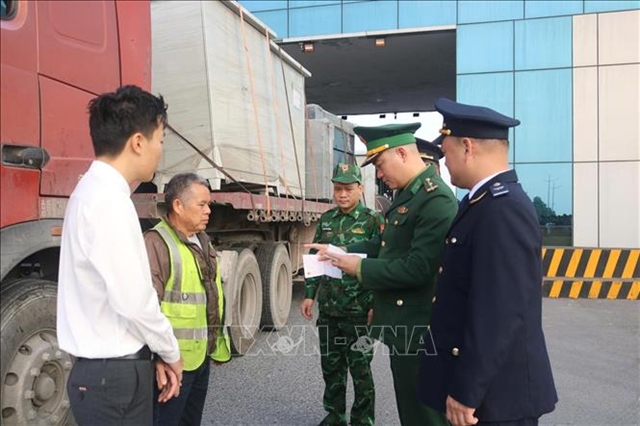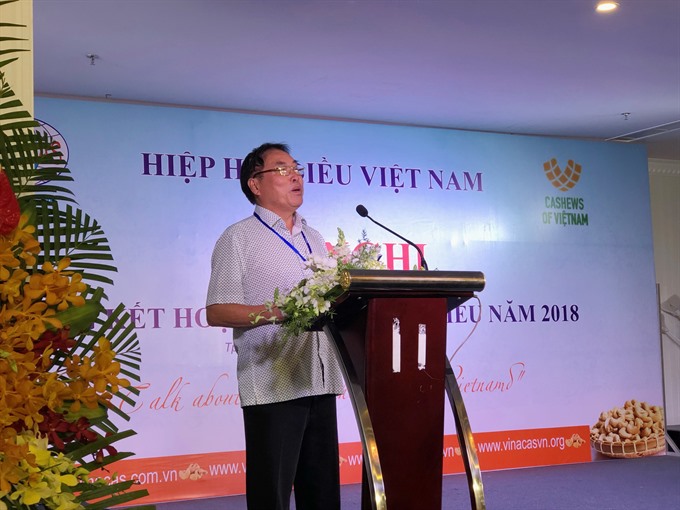 Economy
Economy

Việt Nam’s cashew sector targets exports of 350,000 tonnes this year, 10 per cent lower than last year, according to the Việt Nam Cashew Association (Vinacas).
 |
| Phạm Văn Công, chairman of the Việt Nam Cashew Association, speaks at a seminar in HCM City on Friday to review the performance of the cashew sector last year and set tasks for this year. — VNS Photo Xuân Hương |
HCM CITY — Việt Nam’s cashew sector targets exports of 350,000 tonnes this year, 10 per cent lower than last year, according to the Việt Nam Cashew Association (Vinacas).
This year it plans to focus on developing highly processed products and exporting products with high value-addition, it said.
According to documents tabled at a seminar in HCM City yesterday to review the performance of the cashew sector last year and set tasks for this year, the domestic supply of raw cashew was inadequate. Meanwhile, the prices of imports were too high and their quality was sometimes poor.
Therefore the sector will not increase exports but focus on raising product quality and promote its products in the domestic market.
Last year it processed 1.65 million tonnes of raw cashew and exported 391,000 tonnes for US$3.5 billion, an increase of 7.8 per cent in volume but a slight fall in value from the previous year.
Speaking at the seminar, Nguyễn Minh Họa, deputy chairman of Vinacas, said: “Việt Nam was still the world’s largest cashew processor and exporter last year, but it was not a good year for Vietnamese cashew exporters since many of them incurred losses, some even went bankrupt.”
The price of raw cashew increased sharply last year while the export prices of the processed nut decreased sharply, he said.
Phạm Văn Công, Vinacas chairman, said since the beginning of the crop last year the association had been warning companies to be careful in importing raw cashew because prices were very high. However, many companies, fearing a shortfall, bought large volumes.
Subsequently prices dropped sharply, causing them to incur big losses, he explained.
Việt Nam has around 300,000 hectares under cashew and an average output of 350,000-400,000 tonnes a year, meeting only 25-30 per cent of processors’ demand.
Thus they have to import over 1 million tonnes of raw cashew every year from many countries, mainly in Africa, he said.
To avoid risks this year, Họa said they should keep a close eye on the market situation and do not import large volumes at the beginning of the year when the harvest season begins.
“Raw cashew is now available around the year.
“Based on lesson learned from last year, firms should change their business plan so as to do better this year.”
Vũ Thái Sơn, general director of Long Sơn JSC, one of the country’s biggest cashew exporters, concurred, saying the major supplying countries have very large raw cashew stock.
“We are not worried about lack of raw cashew nuts.”
Firms should not buy raw material in large quantities at the same time, he said.
But with supply being higher than demand, prices of processed nuts are unlikely to increase this year, he said.
Sơn said international roasters and traders expect processed cashew prices to fall and so do not sign long-term contracts with exporters.
“We had many long-term contracts in previous years, but the number of long-term contracts this year is very few.”
With them only signing contracts for two to three months, Vietnamese firms should do the same for buying raw cashew, he said.
Other speakers also suggested that businesses should be cautious when transferring money to sellers’ for buying raw materials because the banks could set them off against sellers’ loans.
Đặng Hoàng Giang, another Vinacas deputy chairman, said the association would organise an international cashew conference in Huế next March and a business trip to study West Asian markets next June to promote Việt Nam’s cashew products. — VNS